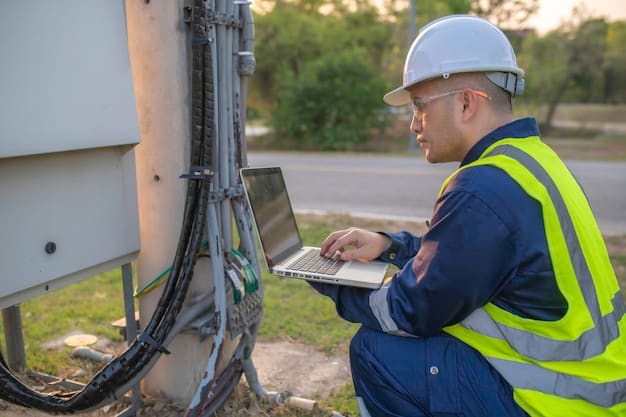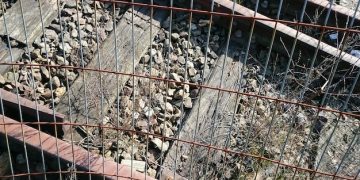US Infrastructure Projects: Modernizing Networks for the Future

US Infrastructure Projects: Modernizing Transportation and Communication Networks involve strategic investments in roads, bridges, broadband, and other essential systems to enhance connectivity, safety, and economic growth nationwide.
The United States is embarking on a transformative journey to modernize its aging infrastructure. These US Infrastructure Projects: Modernizing Transportation and Communication Networks are crucial for bolstering the nation’s economy, improving quality of life, and ensuring global competitiveness. But what exactly do these projects entail, and how will they impact the daily lives of Americans?
Understanding the Urgent Need for Infrastructure Modernization
America’s infrastructure has long been in need of an upgrade. Decades of underinvestment have left roads crumbling, bridges deteriorating, and communication networks lagging behind other developed nations. The consequences of this neglect are far-reaching, impacting everything from economic productivity to public safety.
Recognizing the urgency, both government and private sectors are now prioritizing infrastructure projects aimed at not just repairing existing systems, but also modernizing them to meet the demands of the 21st century.
The Current State of US Infrastructure
The American Society of Civil Engineers (ASCE) consistently gives US infrastructure a middling grade. This assessment highlights the significant deficiencies that need to be addressed to ensure the nation’s infrastructure can support its economic and social needs.
- Roads: Many roads are in poor condition, leading to increased vehicle maintenance costs and traffic congestion.
- Bridges: Thousands of bridges are structurally deficient, posing safety risks to commuters and freight transport.
- Water Systems: Aging water pipes result in significant water loss through leaks and pose potential health hazards.
- Broadband: Millions of Americans, particularly in rural areas, lack access to high-speed internet, hindering economic and educational opportunities.
These issues collectively underscore the compelling need for extensive infrastructure investment.

Modernizing transportation and communication networks is essential for maintaining economic competitiveness, ensuring public safety, and enhancing the overall quality of life for all Americans.
Key Components of the Infrastructure Modernization Plan
The infrastructure modernization plan is comprehensive, addressing various sectors essential for the nation’s growth and well-being. It focuses on transportation, communication, and essential services to ensure the US remains competitive in the global arena.
These modernization efforts are designed not only to fix existing problems but also to lay the groundwork for future innovation and sustainable growth.
Transportation Infrastructure
Transportation is a critical component of the US economy, and modernizing this sector involves several key areas.
- Roads and Highways: Repairing existing roads and building new highways to reduce congestion and improve traffic flow.
- Bridges: Replacing or rehabilitating structurally deficient bridges to ensure safety and reliability.
- Public Transit: Expanding and upgrading public transportation systems, including buses, trains, and subways, to provide efficient and sustainable mobility options.
- Airports: Modernizing airport infrastructure, such as terminals, runways, and air traffic control systems, to enhance safety and reduce delays.
These improvements are geared towards making transportation safer, more efficient, and more environmentally friendly.
Communication Networks
In today’s digital age, robust communication networks are vital for economic development and social connectivity.
- Broadband Expansion: Extending high-speed internet access to underserved rural areas to bridge the digital divide.
- 5G Deployment: Supporting the deployment of 5G networks to enable faster and more reliable wireless communication.
- Cybersecurity: Enhancing cybersecurity measures to protect critical infrastructure from cyber threats.
By strengthening communication networks, the US can foster innovation, promote economic growth, and improve access to education and healthcare.

Funding and Investment Strategies
The success of US Infrastructure Projects: Modernizing Transportation and Communication Networks hinges on securing adequate funding and implementing effective investment strategies. A combination of federal, state, and private sector resources is essential to realize the ambitious goals of these projects.
Strategic financial planning ensures that infrastructure projects are not only initiated but also sustained over the long term, delivering lasting benefits to the nation.
Federal Government Funding
The federal government plays a crucial role in funding infrastructure projects through various programs and initiatives. These federal funds are often matched by state and local governments, amplifying their impact.
Key federal sources of funding include:
- Infrastructure Investment and Jobs Act (IIJA): A landmark legislation that provides billions of dollars for infrastructure improvements across various sectors.
- Department of Transportation (DOT) Programs: Funds allocated for road, bridge, and transit projects through programs like the Federal Highway Administration and the Federal Transit Administration.
- Grants and Loans: Federal grants and low-interest loans offered to states and local governments to support specific infrastructure projects.
Private Sector Involvement
Private sector investment is increasingly recognized as a vital component of infrastructure financing. Public-Private Partnerships (PPPs) are becoming more common, leveraging private capital and expertise to deliver infrastructure projects more efficiently.
PPPs involve contractual agreements between a public agency and a private company to finance, build, operate, and maintain infrastructure assets. This model can accelerate project delivery, reduce costs, and improve the quality of infrastructure services.
The Economic and Social Impact
Modernizing transportation and communication networks yields significant economic and social benefits. These projects create jobs, stimulate economic growth, enhance public safety, and improve the overall quality of life. The impact is felt across various sectors and communities.
By investing in infrastructure, the US is investing in its future, ensuring that it remains a prosperous and competitive nation for generations to come.
Boosting Economic Growth
Infrastructure projects have a multiplier effect on the economy. They create jobs in construction, engineering, and related industries. Furthermore, improved transportation and communication networks enhance productivity, reduce transportation costs, and facilitate trade.
- Job Creation: Construction and maintenance of infrastructure projects generate numerous jobs.
- Increased Productivity: Efficient transportation networks reduce commute times and improve the flow of goods and services.
- Business Expansion: Reliable communication networks enable businesses to expand their operations and reach new markets.
Enhancing Social Well-being
Beyond economic benefits, infrastructure modernization enhances social well-being by improving access to education, healthcare, and other essential services. It also enhances safety and promotes environmental sustainability.
- Improved Access: Modern infrastructure improves access to healthcare, education, and employment opportunities, particularly for underserved communities.
- Enhanced Safety: Upgraded transportation systems reduce accidents and improve emergency response times.
- Environmental Sustainability: Investments in green infrastructure and public transportation promote environmental sustainability and reduce carbon emissions.
Challenges and Obstacles
Despite the numerous benefits, implementing US Infrastructure Projects: Modernizing Transportation and Communication Networks is not without its challenges. Overcoming these obstacles requires careful planning, effective communication, and collaboration among stakeholders.
Addressing these challenges proactively is essential to ensure that infrastructure projects are completed on time and within budget, delivering the intended benefits.
Funding Constraints
Securing adequate funding remains a significant challenge. Infrastructure projects are often expensive and require long-term financial commitments. Balancing competing priorities and securing bipartisan support for funding can be difficult.
Creative financing solutions, such as PPPs and innovative tax incentives, can help bridge the funding gap.
Regulatory Hurdles
Navigating regulatory requirements and obtaining necessary permits can be time-consuming and complex. Environmental reviews, zoning regulations, and other regulatory processes can delay project implementation.
Streamlining regulatory processes and promoting collaboration among regulatory agencies can help expedite project approvals.
Workforce Shortages
The construction industry faces a shortage of skilled workers, which can delay project completion and drive up costs. Attracting and training a new generation of infrastructure workers is essential to meet the growing demand.
Investing in vocational training programs and apprenticeships can help address the workforce shortage and ensure that infrastructure projects have access to skilled labor.
Future Trends in US Infrastructure Development
The future of US Infrastructure Projects: Modernizing Transportation and Communication Networks will be shaped by emerging technologies, sustainability concerns, and evolving societal needs. Embracing innovation and adopting forward-looking approaches will be essential to build resilient and sustainable infrastructure for the future.
Staying abreast of these trends and incorporating them into infrastructure planning will ensure that the US remains at the forefront of infrastructure development.
Smart Infrastructure
The integration of smart technologies, such as sensors, data analytics, and artificial intelligence, is transforming infrastructure development. Smart infrastructure can improve efficiency, enhance safety, and reduce costs.
Examples of smart infrastructure include:
- Smart Roads: Roads equipped with sensors that monitor traffic flow, detect accidents, and adjust traffic signals in real-time.
- Smart Bridges: Bridges with sensors that monitor structural health and provide early warnings of potential problems.
- Smart Grids: Energy grids that use data analytics to optimize energy distribution and reduce waste.
Sustainable Infrastructure
Sustainability is becoming an increasingly important consideration in infrastructure development. Green infrastructure, such as green roofs, permeable pavements, and urban forests, can reduce stormwater runoff, improve air quality, and enhance biodiversity.
Sustainable infrastructure also includes:
- Renewable Energy: Integrating renewable energy sources, such as solar and wind power, into infrastructure projects.
- Energy Efficiency: Designing buildings and transportation systems to minimize energy consumption.
- Resilient Design: Building infrastructure that can withstand the impacts of climate change, such as sea-level rise and extreme weather events.
| Key Point | Brief Description |
|---|---|
| 🛣️ Road Modernization | Repairing and building roads to ease traffic and reduce vehicle maintenance costs. |
| 🌉 Bridge Rehabilitation | Replacing or fixing old bridges to maintain safety and reliability for commuters. |
| 🌐 Broadband Expansion | Extending high-speed internet to rural areas, bridging the digital divide. |
| ⚡ Smart Infrastructure | Using technologies like sensors and AI to improve infrastructure efficiency and safety. |
Frequently Asked Questions
▼
The primary goals include boosting economic growth, enhancing public safety, improving quality of life, and ensuring global competitiveness through upgraded transportation and communication networks.
▼
Funding comes from a mix of federal government initiatives like the Infrastructure Investment and Jobs Act, state and local government contributions, and private sector investments through Public-Private Partnerships (PPPs).
▼
Challenges include securing adequate funding, navigating complex regulatory hurdles, and addressing workforce shortages in the construction and engineering sectors, which can cause project delays.
▼
Technology is crucial, with developments like smart roads and bridges using sensors and AI to improve efficiency and safety. Smart grids also optimize energy distribution, enhancing overall system reliability.
▼
It improves daily life by reducing commute times, enhancing access to high-speed internet, and ensuring safer travel, contributing to increased economic and social opportunities for all citizens.
Conclusion
US Infrastructure Projects: Modernizing Transportation and Communication Networks are vital for ensuring the nation’s future prosperity and competitiveness. By addressing long-standing deficiencies and embracing innovative technologies, the US can build a resilient and sustainable infrastructure that supports economic growth, enhances social well-being, and improves the quality of life for all Americans.





